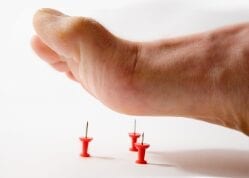Diabetes Neuropathy
Diabetes Neuropathy


The goal of treating diabetic neuropathy is to prevent further tissue damage and relieve discomfort. The first step is to bring blood sugar levels under control by diet and medication. Another important part of treatment involves taking special care of the feet by wearing proper fitting shoes and routinely checking the feet for cuts and infections. Analgesics, low doses of antidepressants, and some anticonvulsant medications may be prescribed for relief of pain, burning, or tingling. Some individuals find that walking regularly, taking warm baths, or using elastic stockings may help relieve leg pain.
The prognosis for diabetic neuropathy depends largely on how well the underlying condition of diabetes is handled. Treating diabetes may halt progression and improve symptoms of the neuropathy, but recovery is slow. The painful sensations of diabetic neuropathy may become severe enough to cause depression in some patients.
PLEASE NOTE:
The information contained in this article is not intended to provide advice for individual problems, nor to substitute for professional advice or care from a physician. For answers to specific questions concerning your personal circumstances, you should consult your physician directly.
